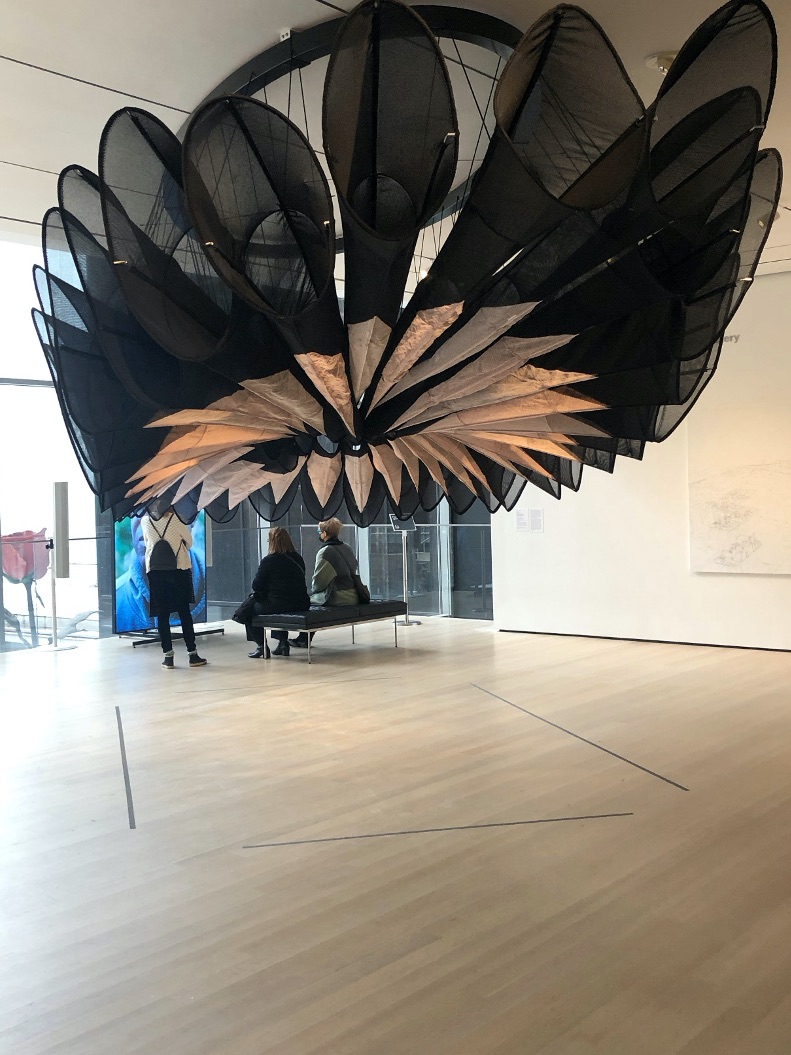This week’s DMTV Milkshake guest is Felecia Davis, designer at Felecia Davis Studio, associate professor at the Stuckeman Center for Design Computing in the School of Architecture and Landscape Architecture at Pennsylvania State University, as well as the director of SOFTLAB@PSU.
In this episode, Davis shares her genre-defying work, research, and design advocacy – some of which is now on view at the Museum of Modern Arts’ show Reconstructions: Architecture and Blackness in America through May 31.
MoMA visitors will have the chance to explore Davis’s dense, layered work with textiles in person, interacting directly with two pieces within a larger project: Fabricating Networks: Transmissions and Receptions from Pittsburgh’s Hill District, 2021. The first, a “transmission quilt,” shares stories from the residents of Pittsburgh’s Hill District when viewers touch the quilt itself. Another piece, the Flower Antenna, has pink copper fabric engineered to pick up electromagnetic waves – from bypassers’ iPhones, for example – and transforms them into a high-pitched sound.

View Under the Flower Antenna, by Felecia Davis. Photo by Germane Barnes, © 2021, Museum of Modern Art, Reconstructions: Architecture and Blackness in America. This is from the project Fabricating Networks: Transmissions and Receptions from Pittsburgh’s Hill District, 2021.
This project uses textiles to explore the invisible electromagnetic waves that shape people’s lives. There are two parts.
The first is a transmission quilt that transmits stories about the Hill District in Pittsburgh, PA. The quilt is activated by touch and the small speaker emits the stories about each panel. This quilt is meant to be a seed to be developed in conjunction and in conversation with residents in the Hill District neighborhoods post the Covid-19 pandemic.
The second is a receiver or the Flower Antenna that is a receiver of invisible electromagnetic waves that outputs as sound the electromagnetic frequencies of people’s iPhones, and other equipment in MoMA’s gallery. This is a high-pitched tone. The pink copper fabric in one of the petals picks up the electromagnetic waves.
Team: Elliot Brau, Thomas Dimick, Berfin Evrim, Jamie Heilman, Taylor Hufnagel, Ciera Jones, Niousha Keyvani, Kristine Luther, Mona Mirzaie, Marzena Nowobilski, Farzaneh Oghazian, Allan Sutley, Lee Washesky, and Steven White Special thanks to Leah Resnick for knit manufacturing, Erin Lewis for her collaboration on the knit antenna, David Riebe of Windsor Fiberglass, the Stuckeman Center for Design Computing, the Stuckeman Center for Collaborative Design Research, the Agnes Scollins Carey Memorial Professorship, Penn State Department of Architecture and the College of Arts and Architecture

View Under the Flower Antenna, by Felecia Davis. Photo by Sean Anderson, © 2021, Museum of Modern Art, Reconstructions: Architecture and Blackness in America. Pink copper yarn allows antenna to pick up electromagnetic signals.
“We’re developing computational textiles — textiles which have sensors, micro-controllers, and other electronics interwoven or embedded in the fibers and fabric, which we make to communicate information to people,”
Davis’s research offers wide-ranging functional applications in hospitals and other institutions, not just museums. “We’re develop computational textiles – textiles which have sensors, micro-controllers, and other electronics interwoven or embedded in the fibers and fabric, which we make to communicate information to people,” she says. “We’re most excited about looking at natural materials that also have properties that can communicate information to people. In the last five years, there’s been an explosion of people looking at biodegradable microcontrollers, for example, that we can include in our work. We’re now starting to have prototypes that work and are ready to connect with communities outside our lab to try out some of our pieces – like wearable leggings or wearable tops.”
Among Davis’s other roles is founding member of the Black Reconstruction Collective, a not-for-profit group of Black architects, scholars and artists facilitating design work about the Black diaspora. “I would say the most valuable thing that the Black Reconstruction Collective is doing is addressing the project of Black emancipation, which at this day and age is incomplete,” Davis says. That facilitation ranges from providing financial support to fomenting a sense of shared intellectual inquiry. “This work will produce new knowledge on this kind of larger project of Black emancipation and Blackness,” Davis says. “As a group, we’re interested in inviting people to open forums so that this project can be discussed at its fullest rate.”

Scene of Fabrication 1, From the Project Fabricating Networks: Transmissions and Receptions from Pittsburgh’s Hill District, 2021 by Felecia Davis © 2021. \\\ Team: Berfin Evrim

Scene of Fabrication 3, From the Project Fabricating Networks: Transmissions and Receptions from Pittsburgh’s Hill District, 2021 by Felecia Davis © 2021. \\\ Team: Berfin Evrim
Diana Ostrom, who has written for Wallpaper, Interior Design, ID, The Wall Street Journal, and other outlets, is also the author of Faraway Places, a newsletter about travel.
Milkshake, DMTV (Design Milk TV)’s first regular series, shakes up the traditional interview format by asking designers, creatives, educators and industry professionals to select interview questions at random from their favorite bowl or vessel. During their candid discussions, you’ll not only gain a peek into their personal homeware collections, but also valuable insights into their work, life and passions.
from WordPress https://connorrenwickblog.wordpress.com/2021/03/10/dmtv-milkshake-felecia-davis-on-creating-a-smarter-better-future/

No comments:
Post a Comment